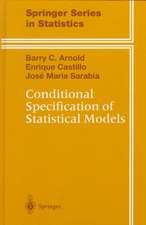Expert Systems and Probabilistic Network Models: Monographs in Computer Science
Autor Enrique Castillo, Jose M. Gutierrez, Ali S. Hadien Limba Engleză Paperback – 15 sep 2011
Din seria Monographs in Computer Science
- 20%
 Preț: 1322.33 lei
Preț: 1322.33 lei - 20%
 Preț: 511.92 lei
Preț: 511.92 lei - 20%
 Preț: 1285.31 lei
Preț: 1285.31 lei - 20%
 Preț: 333.22 lei
Preț: 333.22 lei - 20%
 Preț: 328.60 lei
Preț: 328.60 lei - 15%
 Preț: 646.94 lei
Preț: 646.94 lei - 20%
 Preț: 357.48 lei
Preț: 357.48 lei - 20%
 Preț: 339.47 lei
Preț: 339.47 lei - 20%
 Preț: 653.21 lei
Preț: 653.21 lei - 20%
 Preț: 329.44 lei
Preț: 329.44 lei - 20%
 Preț: 993.74 lei
Preț: 993.74 lei - 20%
 Preț: 992.26 lei
Preț: 992.26 lei - 20%
 Preț: 1630.95 lei
Preț: 1630.95 lei - 20%
 Preț: 656.03 lei
Preț: 656.03 lei - 20%
 Preț: 650.08 lei
Preț: 650.08 lei - 20%
 Preț: 328.09 lei
Preț: 328.09 lei - 20%
 Preț: 641.16 lei
Preț: 641.16 lei - 20%
 Preț: 334.38 lei
Preț: 334.38 lei - 18%
 Preț: 737.74 lei
Preț: 737.74 lei - 20%
 Preț: 642.19 lei
Preț: 642.19 lei - 20%
 Preț: 641.99 lei
Preț: 641.99 lei - 20%
 Preț: 345.59 lei
Preț: 345.59 lei - 20%
 Preț: 711.29 lei
Preț: 711.29 lei - 20%
 Preț: 1001.16 lei
Preț: 1001.16 lei - 20%
 Preț: 661.47 lei
Preț: 661.47 lei - 20%
 Preț: 343.62 lei
Preț: 343.62 lei - 20%
 Preț: 644.81 lei
Preț: 644.81 lei - 15%
 Preț: 505.30 lei
Preț: 505.30 lei - 20%
 Preț: 640.69 lei
Preț: 640.69 lei -
 Preț: 396.78 lei
Preț: 396.78 lei - 18%
 Preț: 956.81 lei
Preț: 956.81 lei - 20%
 Preț: 592.68 lei
Preț: 592.68 lei - 20%
 Preț: 329.44 lei
Preț: 329.44 lei -
 Preț: 383.33 lei
Preț: 383.33 lei - 20%
 Preț: 349.40 lei
Preț: 349.40 lei - 20%
 Preț: 993.42 lei
Preț: 993.42 lei - 15%
 Preț: 578.87 lei
Preț: 578.87 lei - 20%
 Preț: 337.85 lei
Preț: 337.85 lei - 20%
 Preț: 988.16 lei
Preț: 988.16 lei - 20%
 Preț: 996.56 lei
Preț: 996.56 lei - 20%
 Preț: 1293.37 lei
Preț: 1293.37 lei - 20%
 Preț: 1452.94 lei
Preț: 1452.94 lei
Preț: 832.40 lei
Preț vechi: 1040.50 lei
-20% Nou
Puncte Express: 1249
Preț estimativ în valută:
159.30€ • 165.70$ • 131.51£
159.30€ • 165.70$ • 131.51£
Carte tipărită la comandă
Livrare economică 14-28 aprilie
Preluare comenzi: 021 569.72.76
Specificații
ISBN-13: 9781461274810
ISBN-10: 1461274818
Pagini: 624
Ilustrații: XIV, 605 p.
Dimensiuni: 155 x 235 x 33 mm
Greutate: 0.86 kg
Ediția:Softcover reprint of the original 1st ed. 1997
Editura: Springer
Colecția Springer
Seria Monographs in Computer Science
Locul publicării:New York, NY, United States
ISBN-10: 1461274818
Pagini: 624
Ilustrații: XIV, 605 p.
Dimensiuni: 155 x 235 x 33 mm
Greutate: 0.86 kg
Ediția:Softcover reprint of the original 1st ed. 1997
Editura: Springer
Colecția Springer
Seria Monographs in Computer Science
Locul publicării:New York, NY, United States
Public țintă
Professional/practitionerCuprins
Preface.- 1 Introduction.- 1.1 Introduction.- 1.2 What Is an Expert System?.- 1.3 Motivating Examples.- 1.4 Why Expert Systems?.- 1.5 Types of Expert System.- 1.6 Components of an Expert System.- 1.7 Developing an Expert System.- 1.8 Other Areas of AI.- 1.9 Concluding Remarks.- 2 Rule-Based Expert Systems.- 2.1 Introduction.- 2.2 The Knowledge Base.- 2.3 The Inference Engine.- 2.4 Coherence Control.- 2.5 Explaining Conclusions.- 2.6 Some Applications.- 2.7 Introducing Uncertainty.- Exercises.- 3 Probabilistic Expert Systems.- 3.1 Introduction.- 3.2 Some Concepts in Probability Theory.- 3.3 Generalized Rules.- 3.4 Introducing Probabilistic Expert Systems.- 3.5 The Knowledge Base.- 3.6 The Inference Engine.- 3.7 Coherence Control.- 3.8 Comparing Rule-Based and Probabilistic Expert Systems.- Exercises.- 4 Some Concepts of Graphs.- 4.1 Introduction.- 4.2 Basic Concepts and Definitions.- 4.3 Characteristics of Undirected Graphs.- 4.4 Characteristics of Directed Graphs.- 4.5 Triangulated Graphs.- 4.6 Cluster Graphs.- 4.7 Representation of Graphs.- 4.8 Some Useful Graph Algorithms.- Exercises.- 5 Building Probabilistic Models.- 5.1 Introduction.- 5.2 Graph Separation.- 5.3 Some Properties of Conditional Independence.- 5.4Special Types of Input Lists.- 5.5 Factorizations of the JPD.- 5.6 Constructing the JPD.- Appendix to Chapter 5.- Exercises.- 6 Graphically Specified Models.- 6.1 Introduction.- 6.2 Some Definitions and Questions.- 6.3 Undirected Graph Dependency Models.- 6.4 Directed Graph Dependency Models.- 6.5 Independence Equivalent Graphical Models.- 6.6 Expressiveness of Graphical Models.- Exercises.- 7 Extending Graphically Specified Models.- 7.1 Introduction.- 7.2 Models Specified by Multiple Graphs.- 7.3 Models Specified by Input Lists.- 7.4 Multifactorized Probabilistic Models.- 7.5 Multifactorized Multinomial Models.- 7.6 Multifactorized Normal Models.- 7.7 Conditionally Specified Probabilistic Models.- Exercises.- 8 Exact Propagation in Probabilistic Network Models.- 8.1 Introduction.- 8.2 Propagation of Evidence.- 8.3 Propagation in Polytrees.- 8.4 Propagation in Multiply-Connected Networks.- 8.5 Conditioning Method.- 8.6 Clustering Methods.- 8.7 Propagation Using Join Trees.- 8.8 Goal-Oriented Propagation.- 8.9 Exact Propagation in Gaussian Networks.- Exercises.- 9 Approximate Propagation Methods.- 9.1 Introduction.- 9.2 Intuitive Basis of Simulation Methods.- 9.3 General Frame for Simulation Methods.- 9.4 Acceptance-Reject ion Sampling Method.- 9.5 Uniform Sampling Method.- 9.6 The Likelihood Weighing Sampling Method.- 9.7 Backward-Forward Sampling Method.- 9.8 Markov Sampling Method.- 9.9 Systematic Sampling Method.- 9.10 Maximum Probability Search Method.- 9.11 Complexity Analysis.- Exercises.- 10 Symbolic Propagation of Evidence.- 10.1 Introduction.- 10.2 Notation and Basic Framework.- 10.3 Automatic Generation of Symbolic Code.- 10.4 Algebraic Structure of Probabilities.- 10.5 Symbolic Propagation Through Numeric Computations.- 10.6 Goal-Oriented Symbolic Propagation.- 10.7 Symbolic Treatment of Random Evidence.- 10.8 Sensitivity Analysis.- 10.9 Symbolic Propagation in Gaussian Bayesian Networks.- Exercises.- 11 Learning Bayesian Networks.- 11.1 Introduction.- 11.2 Measuring the Quality of a Bayesian Network Model.- 11.3 Bayesian Quality Measures.- 11.4 Bayesian Measures for Multinomial Networks.- 11.5 Bayesian Measures for Multinormal Networks.- 11.6 Minimum Description Length Measures.- 11.7 Information Measures.- 11.8 Further Analyses of Quality Measures.- 11.9 Bayesian Network Search Algorithms.- 11.10 The Case of Incomplete Data.- Appendix to Chapter 11: Bayesian Statistics.- Exercises.- 12 Case Studies.- 12.1 Introduction.- 12.2 Pressure Tank System.- 12.3 Power Distribution System.- 12.4 Damage of Concrete Structures.- 12.5 Damage of Concrete Structures: The Gaussian Model.- Exercises.- List of Notation.- References.























